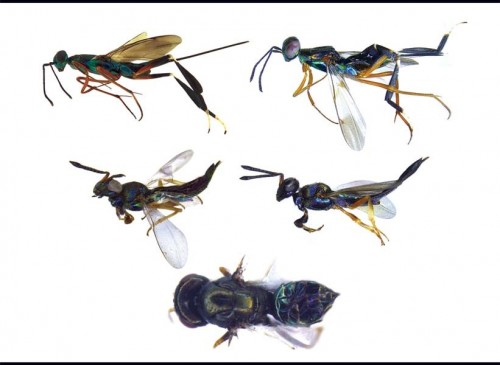RESEARCH: India is home to the largest wild tiger population in the world. The Indian tigers are sometimes also known as the Royal Bengal Tigers (Panthera tigris tigris) also found in Bangladesh, Nepal, Bhutan, China and Burma. Found in fragmented pockets all across the country, there has been speculations however that the tigers of Sundarbans are a distinct subspecies and not closely related to the rest of the tigers found in India. But a new study shows the Sunderbans tiger actually is a close relative of the tigers found in Central India and has been isolated recently, may be 300-1000 years ago.
Genetic studies of the tiger that resides in the Sundarbans mangrove forests of West Bengal, has revealed that this royalty has ancestors that can be traced back to central India and are not that different from the present day tigers found in Central regions of India, at the genetic level.
The study was conducted by scientist SP Goyal and researchers Sujeet Kumar Singh and Sudhanshu Mishra from Wildlife Institute of India (WII). The scientists say that the Bengal tigers are actually an isolated population of the central Indian tigers. The separation occurred between 300 and 1000 years ago due to historical events, human pressure, and land-use patterns.
“Our study has found that the gene pattern of the Sunderbans tiger is identical to the big cat population of the central India landscape, including states like Madhya Pradesh, Maharashtra, Chhattisgarh and parts of Andhra Pradesh,” said Goyal.
Different Appearance, Similar Genes
In 2009, US scientist Adam Barlow had found that the Sunderbans tiger is morphologically distinct in terms of skull and body size from other tigers. The researcher therefore thought that further studies were needed to see if the tigers came from an evolutionary distinct line.
But the present study shows that this may not be the case.
For the WII report titled ‘Tigers of Sunderbans Tiger Reserve: Is This Population a Separate Evolutionary Significant Unit’ the scientists used a method called DNA haplotyping and fragment analysis to study the genetic pattern of the tigers. Haplotypes are a set of closely linked genetic markers present on one chromosome which tend to be inherited together. When the DNA Haplotypes of the Sundarbans tigers were compared with that of tigers of Madhya Pradesh and Maharashtra, the pattern was found to be identical.
Goyal said Sunderbans tiger showed identical allelic or gene pattern as observed in the tigers of MP parks, including Bandhavgarh, Kanha, Pench, and reserves like Tadoba and Nagzira in Maharashtra.
Going back in time
While the present study has helped determine that Sundarban tigers are not really genetically different from tigers of central India, it is still not clear when the population separation took place.
For any animal population to be called a subspecies, it has to genetically isolated from the rest of the population for at least 20,000-50,000 years. For example, the Sumatran tiger and the Siberian tiger are two distinct subspecies of the tiger. Also, for an animal population to be declared a separate species it has to remain isolated for a period of one million years or more.
Therefore, can Indian tigers separately living in Central states, Southern states or Eastern states be termed as separate subspecies? No, finds an earlier study by eminent scientists, John Seidensticker, Sandeep Sharma and Hemendra Panwar. The study said that while tigers populated central India about 10, 000 years ago, their population subdivision began only about 1000 years ago and accelerated only 200 years ago owing to habitat fragmentation.
Going back in time, tigers were most probably seen in West Bengal and the Sunderbans as early as the year 1756.
In historian Rajat Roy’s words, in 1756, when Siraj-Ud-Daulah recaptured the city of Kolkata (then Calcutta) from the British, today’s Salt Lake area used to be the main city then and the Lower South Circular Road that’s now known as Chowringhee used to be the city’s southern border.
“Beyond that were the forests of Sunderbans and there are beliefs that tigers were often sighted in those forests which now house busy localities like Tollygunge and Behala,” said Roy, also the professor emeritus of Presidency University.
Present study authors say that they will need to further analyse the history to understand when the separation of the Sundarban tiger population occurred but this much is clear that the fragmentation occurred due to habitat fragmentation, human pressure and rise in demand for agriculture lands.
This can be proven from the fact that central India’s key tiger area Satpura-Maikal, has already lost 78% forest cover to farmlands and urbanization. In the last 300 years, there was 22-fold increase in agricultural area and 25-fold rise in urbanization in this landscape.
Closer cousins
Interestingly, while the study points that central Indian tigers and sundarban tigers have the same ancestors, the later have been found to be different genetically from the North Indian tigers, found in Corbett national park for example.
The WII study found there was highest population differentiation between the Royal Bengal tigers and the tigers from North of India which, according to Goyal, only proves that Sunderbans tigers are genetically more close to central Indian big cat population.
Additional PCCF (wildlife) Pradeep Vyas said, “If the British rulers didn’t declare the Sunderbans as reserve forest sometime around 1880, the tiger population would have isolated far beyond,” he said, adding that this should not be a conclusive study and further experimentation should be encouraged.
The study definitely opens new doors of exploration for scientists to ascertain the evolutionary history of all separate populations of tigers in India. It also shows how humans have been responsible in a major way separating these tiger populations.
More Related Stories,
Scientists Successfully Sequence entire Tiger Genome
India’s Second Special Tiger Protection Force formed in Simlipal
Eight Reasons why Tiger are Dying
Image by Todd , iamNigelMorris, via cc/Flickr











3 thoughts on “Sundarban Tigers Closely Related to Tigers from Central India”